
By Mayor Emeritus Eugene C. Brune
42 years ago, this past Sunday and only in my twelfth week as mayor, I had my “baptism by fire,” so to speak. At about 8:30 a.m. on the morning of April 3, 1980, I received a telephone call at my home, just as I was about to leave for my office.
I was notified that there was an accident at the B&M yard. A Boston and Maine switching engine, consisting of a locomotive and 38 cars,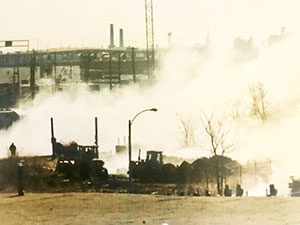 rammed the side of a tank car. It pierced the skin of steel, 7/16” thick on a container car, causing a 16” long gash into the container. The damaged container was carrying 13,000 gallons of phosphorus trichloride. The chemical was spilling out of the tank car at the rate of 100 gallons per minute. It was televised as the worst chemical spill in the history of the Commonwealth.
rammed the side of a tank car. It pierced the skin of steel, 7/16” thick on a container car, causing a 16” long gash into the container. The damaged container was carrying 13,000 gallons of phosphorus trichloride. The chemical was spilling out of the tank car at the rate of 100 gallons per minute. It was televised as the worst chemical spill in the history of the Commonwealth.
When I got to the scene of the accident, I thought that I was on a movie set. I saw smoke billowing all over the sky, police cars, ambulances, fire engines from several cities, civil defense cars, bulldozers and sad to say, firemen being treated. It really looked like a movie made for television, only it was real.
My first order was to call for the evacuation of the immediate area. I later expanded that evacuation to several thousand residents.
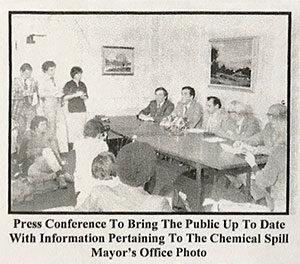 I said to my staff, “It looks like we have much to do, and we better do it right.” The press was after me to make a statement, but I knew that first I had to meet with my Fire Chief Charlie Donovan to find out the facts and exactly where we stood at that point. I also needed to find out all that I could in just minutes what kind of toxic chemical “phosphorus trichloride” was.
I said to my staff, “It looks like we have much to do, and we better do it right.” The press was after me to make a statement, but I knew that first I had to meet with my Fire Chief Charlie Donovan to find out the facts and exactly where we stood at that point. I also needed to find out all that I could in just minutes what kind of toxic chemical “phosphorus trichloride” was.
I called for a press conference at my office soon after I got myself organized. Every television and radio station in the state was at City Hall. I explained to them that the chemical, phosphorus trichloride, was a clear colorless and highly volatile liquid that was corrosive to most metals.
If this substance came in contact with the skin, it would produce major burns. Also, the chemical was so strong that it could very quickly turn the chrome or other parts of a vehicle into rust. Most importantly, I informed everyone that very serious health problems could develop in those breathing this very potent and dangerous chemical.
We set up a command center at the site and also at my office. Knowing that this would be an all-nighter. I had my staff set up space, telephones, coffee etc., for the press. I found out later that this was a gesture that they all appreciated. I just thought it was the right thing to do.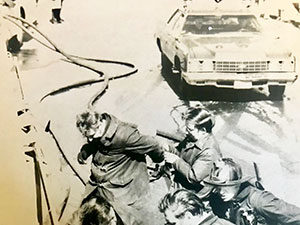
One of the most serious problems was keeping the flowing chemical away from the sewer system. In order to avoid this the fire department needed to get a front-end loader and make a trench so that the chemicals would not spread to the Joy St. storm drains. In so doing our firemen, without protective suits and breathing equipment were exposed to the physical effects this chemical had on them.
One Monsanto expert informed us that when water is poured onto phosphorus trichloride a cloud of hydrochloric acid and phosphorus acid (both toxic} is formed. I decided to err on the side of caution and when the wind started to shift, I ordered the evacuation of all homes from Washington St. to Cross St. By the end of the day, I had ordered the evacuation of about 14,000 citizens, including the school children from the Pope and the East Somerville Schools.
The real heroes were the firemen. I was never so proud of our firemen as I was that day. Each of them did an outstanding job. Sad to say we had several casualties. Firefighters Kevin F. Sullivan, Anthony McDade, and Lieutenant Edward L Clifford were all permanently disabled as a result of injuries received at this spill. A fourth firefighter, Robert J Wilker, was injured and spent over a week in the hospital.
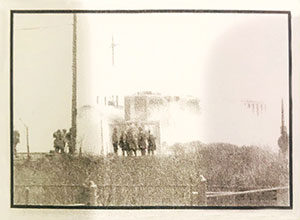 In speaking with the State Secretary of Public Safety as well as the State Civil Defense Director, I was told that, like it or not, as mayor I was in complete control of everything that happened. Suggestions could be offered, but all decisions and orders had to come from me. What was it Harry Truman once said? “The buck stops here.” It was true.
In speaking with the State Secretary of Public Safety as well as the State Civil Defense Director, I was told that, like it or not, as mayor I was in complete control of everything that happened. Suggestions could be offered, but all decisions and orders had to come from me. What was it Harry Truman once said? “The buck stops here.” It was true.
Later I found out that we still had 6000 gallons of phosphorous trichloride that’s settled into the ground. Our problem was that we had to rid the ground of every aspect of the chemical. We could not allow the ground to remain contaminated.
The chemical engineers came up with what they thought would be the best solution. If we poured 10 parts water to one part chemical, this might rid the ground of any contamination. However, this choice could very well cause a huge amount of white chemical smoke to hang over our city, as well as surrounding cities such as Cambridge, Medford or Charlestown. Naturally, if the wind blew the result would be even more disastrous and could force even more evacuations. I was also worried about the possibility of having to evacuate the Somerville Hospital. As it stood, I had already evacuated over 14,000 people during the day.
Another possibility was the pour 10 parts sand to one part chemical into the ground. The downside might be that the sand would not work, and the ground would remain contaminated.
After giving it some serious thought, my decision was to pour sand and not water on the contaminated ground. We would also test the ground daily for the next two weeks. Each and every person in the room proceeded to tell me that they were happy with my decision and I went away feeling hopeful. It did work.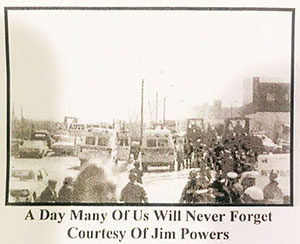
I would be remiss if I didn’t give huge thanks to Fire Chief Charlie Donovan, Deputy Chief John Brosnahan, and Lt. Frank Kelly for their prompt actions throughout that fateful day and night.
During that day the Somerville hospital examined over 500 residents and admitted two firefighters. Mass General Hospital examined 20 and admitted one firefighter. The Lawrence Memorial Hospital examined 13 and admitted one firefighter, and Central Hospital examined 30.
There were so many volunteers who were so great to us. These included nurses, entertainers, food companies, John and Joann Sacco the owners of Dicks Service Center, Cataldo Ambulance, Holiday Inn, bus companies, The MDC Police and the Somerville Police Department. Amazingly, we did not have one case of looting in the city.
That day I saw fear in the eyes of my constituents, the uncertainty of families leaving their homes not knowing when and if they could return, and firemen who risked their lives combating a highly potent and foreign substance. Those were the lasting impressions that I still have today.















I was at the Conwell at the time, so not near the accident, but I remember my mother having her shift at Somerville Hospital extended and hearing about the number of people they saw that day.
Nice story by former Mayor Brune. I was assigned at the time on Ladder 2 in Group 2 out of Headquarters on Broadway. As we neared the scene we saw the cloud and knew this was going to be a challenge,
As we turned onto Joy Street our exposed skin started to burn from the fumes. The liquid was running down the street bubbling. Deputy Chief Brosnahan instructed us to divert the flowing liquid away from the storm and sewer drains. I remember a red Chevy Impala parked on Joy Street.
At the end of the day it was white because the leaking fumes eat the red pigment out of the red paint. The green shamrocks on my helmet turned silver and the copper piping on our apparatus turned green.
at the hospital I discovered that all the coins in my pocket had also turned green. This incident was handled very well due to training, preparedness, and good coordination, communication, and leadership from Mayor Brune, Fire Chief Donovan, Police Chief Pino, Deputy Chief Brosnahan, firefighters, police officers, EMS, and other agencies.
I will never forget the size of the chemical cloud in the air. The people of Somerville can be sure that any incident like this in the future will be handled properly. You have an excellent fire department, police department, EMS personnel, and other agencies.